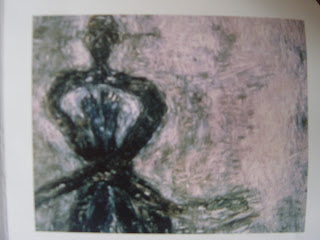A fitting intro to art of Susan Rothenberg at Santa Fe's Georgia O'Keeffe museum. First, "Cabin Fever," image of horse and shadow with a line down the middle. (photo below) Quote from artist says she was thinking of cave paintings and fascinated with stopping the motion of things; that's what she thought the line did. It made me think of a bug on a pin, though. The legs were in running position, but I saw no motion, no life. In the same room, "Squeeze," black outline on white of horse's legs, hoofs up, with a line through them, looking, she admits, as though they are hanging in a butcher shop. At bottom, held between the legs, a horse's head, in outline: on the left, open lips; on the right, a stubby ear, and a curve as though the head were cut off just below the jaw, with no neck. My reaction: this is horrible.
There's a hallway between that gallery room and the next where they normally hang a painting on each side. In it, I saw a little boy cover his eyes and hide his face against his mother's shoulder. I stepped in to see what caused this. Was it "Hands and Shadows," with two raised arms casting shadows that look like dragons? Or "Outline," with another horse head at lower right, looking as though it had decayed to the shape of an oven mitt-- no eyes, no ears, just those open lips on the end.
Rothenberg observes that she hardly ever paints a whole figure, at least not of human beings. She also says she doesn't necessarily know exactly what she is painting-- could be this, could be that. I finally decided she is alarmed by the world, especially when something fast, loud or odd happens. And she does not love the world (in contrast to O'Keeffe, who was immersed in the beauty of form and color.) A final painting showed me why: "Folded Buddha," also below. A black figure with crossed arms holds blue legs folded upward, the feet pressed into a hollow chest. "We revolve around an empty middle," she says. That explained the hideousness of the paintings, and the only human-ish faces she places on the borders of some-- they have no life. Even those that are supposed to be observing and reacting to the action of the painting show no connection with it. They are blank. I think the poor woman has no awareness of the human soul, and certainly no hint of a creator God. Utterly opposite to O'Keeffe, who said that God told her, if she painted the Pedernal mountain enough, she could have it. An O'Keeffe I never saw before: "The Beyond," done in 1972, when I believe she was starting to think about the next life. Bottom third is black, then a band of cloudy blue, a strip of white, reflecting light like the moon, then more cloudy blue. What struck me was that the black was closest to the viewer, as though this world is the dark one, but there is light, clarity, up ahead. For now, we see through a glass darkly...
 |
| The motionless horse |
 |
| The empty soul |
 |
| Antidote: dancing St. Francis |
Whaaattt? Orlando is not your favorite city?
ReplyDeleteUmmmm...
ReplyDelete